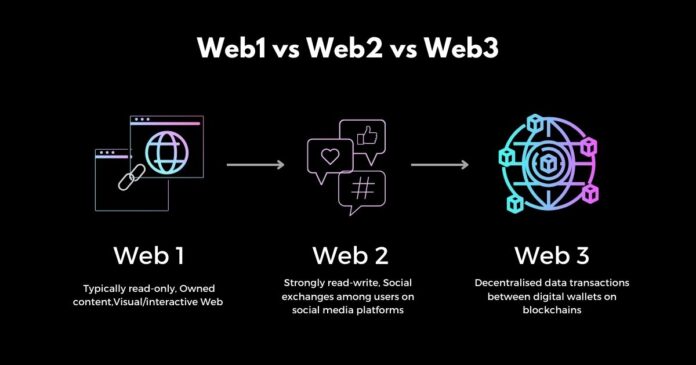Introduction to Web3
Understanding Blockchain Technology
Web3, the next generation of the internet, is built on the foundation of blockchain technology. This decentralized ledger allows for secure and transparent transactions without the need for intermediaries.
- Key Features of Blockchain:
- Decentralization: No single entity controls the network.
- Transparency: Every transaction is recorded on a public ledger.
- Immutability: Once data is entered, it cannot be altered.
Imagine a world where your data belongs entirely to you, free from the clutches of big tech companies. This is the promise that blockchain holds.
Evolution of Web 2.0 into Web3
While Web 2.0 democratized online communication, having moved from owner-driven to user-generated content, a host of issues related to data ownership and privacy have also risen.
- Web3 enables the solution of the above problems-owning one’s data and being involved in online economies-facilitated by technologies such as:
- Smart Contracts: A self-executing contract whereby the terms of agreement are directly written into lines of code. Tokenization: It is a kind of digitalization of an asset right into a token on a blockchain.
Moving from Web 2.0 to Web3 is a serious transition to a more user-centric web, in an evolution grown from a much-desired and present interest in exercising more agency over personal information. Indeed, much learning is to take place about the interaction of these technologies and how life in a digital world is reshaped.

Benefits of Web3
Decentralization and Data Privacy
But perhaps the biggest advantage of Web3 is the decentralization it brings with it to give users back their rights in terms of their data. While the conventional internet has all the data stored on some central servers, Web3 is distributed.
Advantages of Decentralization:
Enhanced Privacy: Users can own their data, sharing it only with whom they choose. Censorship Resistance: No single power can control or censor the content.
The present transition will protect the information of the users in order to build credibility and later have all transactions and interactions traceable, transparently.
Smart Contracts and Tokenization
Another interesting side of Web3 is the integrations of smart contracts and tokenization at the digital ecosystem level. Smart contracts automatically enforce the rules of an agreement in a trustless manner with no middlemen.
Benefits of Smart Contracts:
Efficiency: Transaction time is better, as processes are automated.
Cost Savings: Consume lower charges without using any intermediary.
Tokenization is further revolutionary regarding ownership, as an asset is basically digitized into tokens. Thus, enthusiasts will:
Buy or sell fractional ownership in high-value assets or trade it.
NFTs represent an investment in singular opportunities.
Cumulatively, these will be empowering to people, extending innovative economic structures far and deep in the emergent landscape of Web3.
 Web3 Across Various Industries
Web3 Across Various Industries
Finance and Banking
The arrival of Web3 in finance and banking is quite revolutionary. It introduces such disruptive concepts as DeFi, decentralized finance. Traditional banking can often be a headache: much hassle, delays, and many fees. However, with DeFi, individuals can enjoy faster and cheaper options for borrowing, lending, and trading.
Key Characteristics of DeFi:
Accessibility: Anyone with an internet connection can participate, removing barriers to entry.
Transparency: All the transactions go to the blockchain, thus all are visible.
You might lend your assets and get interest, never having to go to a bank; this is all that comes true with Web3.
Healthcare and Pharmaceutical
Web3 will disrupt the health and pharmaceutical industry in respect of data privacy for better patient outcomes.
Benefits in Healthcare:
Patient Empowerment: Blockchain can allow patients to control and share their health records securely.
Drug Traceability: Pharmaceuticals employ blockchain in tracing the supply chain to ensure it is safe and authentic.
It will also be a frictionless environment in which the interaction between the patient and caregiver for better outcomes is much better positioned to engender trust in care. We talk about seismic revolution-with the integration of Web3, it brings efficiency, transparency, and empowerment in the various industries.
Web3 Applications NFTs and Digital Ownership
The actual use cases are far more subtle than that. Probably one of the most interesting developments to come out of Web3 thus far has been the NFTs-unique, digital assets that changed the whole notion of ownership in the digital world.
Key Features of NFTs:
Authenticity: It has been verifiable on a blockchain; hence, original.
Creative Empowerment: Artists and creators can directly monetize their work without intermediaries.
Imagine owning a digital version of art-say, a painting. Up until today, collectors didn’t have a way to invest in the investment of digital goods through the entire economy of singular digital ownership; that required NFTs.
Decentralized Finance (DeFi) Platforms Equally, besides NFTs, DeFi, or decentralized finance, breaks a number of barriers imposed by conventional finance. With smart contracts on blockchain networks, users can get access to lending, staking, and trading solutions all devoid of banks. Advantages of DeFi: Lower Fees: Eliminating intermediaries often translates to reduced transaction costs.
Global inclusion describes a DeFi platform being open to all people worldwide. From hailing a taxi to managing assets, earning interest, and taking loans, all this can today be done with one simple application on their phones. It isn’t only a democratization of finance but a movement-something intelligent, empowering, and changing the way one thinks about money. And as we journey deeper into the uncharted expanse of Web3, these applications are barely a starting point toward unlimited possibility.


 Web3 Across Various Industries
Web3 Across Various Industries